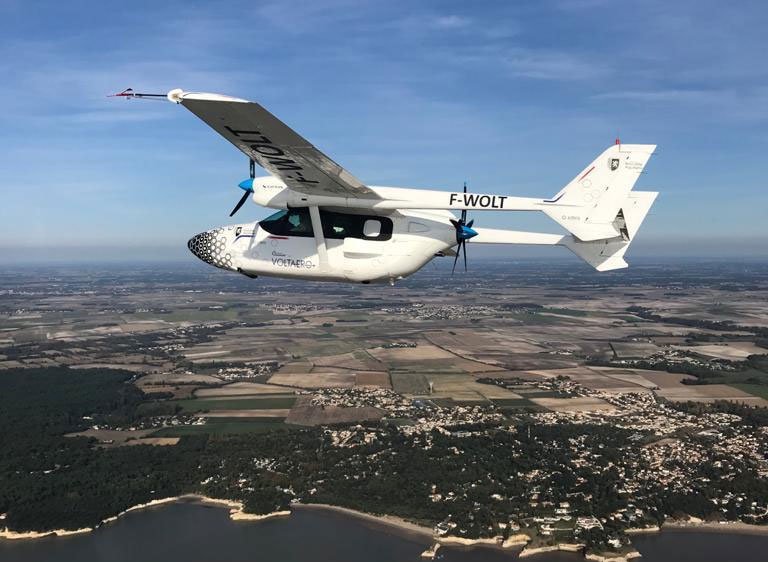VoltAero has just achieved a major milestone with Cassio 1, which first used its hybrid electric propulsion module on October 11, 2020. This module will be installed on the family of 4- to 10-seat regional jets currently under development, the Cassio 330, Cassio 480 and Cassio 600, the latter developing a total combined power of 800 hp.
Electric propulsion module at the back
Cassio 1 made its first flight with its electric propulsion module on Sunday, October 11, 2020, taking off from Royan-Médis airport. Two additional flight evaluations were carried out over the next two days. This is a major step for VoltAéro towards the development of a family of mass-produced hybrid-electric aircraft for regional air transport, which will be able to accommodate 4 to 10 passengers, with autonomy of up to 1,200 km.
The power module of Cassio 1 is installed in a propulsive position in the aft fuselage. It combines three high-performance 60 kW electric motors arranged in a triangular configuration, with a 370 hp internal combustion engine. This power module configuration prefigures the complet" The start of flight testing of the electric modules represents a real milestone for hybrid-electric aviation. It will enable us to achieve our goal of bringing the production configuration Cassio aircraft into service by the end of 2022 or early 2023," said Jean Botti, VoltAero's CEO and CTO.e powertrain for the 10-passenger Cassio 600, which is expected to deliver a total hybrid electric power of 600 kW (800 hp), enabling a cruising speed of 200 kts (370 km/h). "The start of flight tests of the electric modules represents a real milestone for hybrid electric aviation. It will enable us to achieve our objective of bringing the production configuration Cassio aircraft into service at the end of 2022 or early 2023," explained Jean Botti, VoltAero's CEO and Chief Technology Officer.
72 Decibels and a high-level security
In normal time, the electric motors will be used for takeoffs and landings with a low noise level (72 dB), with the internal combustion engine serving as a "range extender" and for recharging the Cassio's batteries at altitude. The VoltAero's power module can operate in modes ranging from full electric to full hybrid, depending on the customer's mission profile and range requirements. In addition, because the electric motors and the internal combustion engine are connected to a common shaft that drives a five-blade propeller, the ability for each to operate independently provides a high level of propulsion safety - with one source acting as a back-up power unit in the event of a problem or failure of the other.
In addition to the Cassio 1 power module, the flight test aircraft is equipped with two wing-mounted ENGINeUS 45 electric engines, supplied by Safran Electrical & Power and installed in a tractive position. Prior to last weekend's maiden flight, when VoltAero added the rear-mounted propulsive power module, Cassio 1 had logged 14 hours and 25 altitude flights with these 45 kW electric engines (70 kW maximum) in a full range of operating conditions.
French airports tour
Cassio 1 will also serve to promote an entire ecosystem around hybrid electric regional air transport. VoltAero and its partner Edeis organized a demonstration tour in France. Cassio 1 will visit 11 destinations between 26 and 31 October 2020 (weather permitting). Cassio 1 will thus take off from Vannes in Brittany and will make stopovers in airports serving the cities of Tours, Le Havre, the Paris region (Toussus-le-Noble), Troyes, Dijon, Annecy, Aix, Nîmes and Toulouse, to finish with the arrival of Cassio 1 in Angoulême. Guided tours of Cassio 1 and information sessions will be conducted at each destination, offering insight into how Cassio hybrid-electric aircraft can contribute to clean, quiet and efficient air transport with regional airports. Participants invited to the stopovers include elected officials, business leaders, air service providers, airport operators and other key players in the transportation infrastructure.
https://www.air-cosmosboutique.com/produit/abonnement-numerique-1-an-aircosmos/

